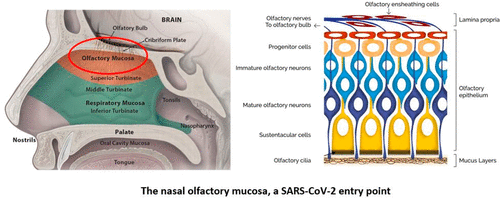当前位置:
X-MOL 学术
›
ACS Chem. Neurosci.
›
论文详情
Our official English website, www.x-mol.net, welcomes your feedback! (Note: you will need to create a separate account there.)
Central Nervous System Targets and Routes for SARS-CoV-2: Current Views and New Hypotheses.
ACS Chemical Neuroscience ( IF 5 ) Pub Date : 2020-08-26 , DOI: 10.1021/acschemneuro.0c00434 Francisco J Barrantes 1
ACS Chemical Neuroscience ( IF 5 ) Pub Date : 2020-08-26 , DOI: 10.1021/acschemneuro.0c00434 Francisco J Barrantes 1
Affiliation

|
As the coronavirus disease 2019 (COVID-19) pandemic unfolds, neurological signs and symptoms reflect the involvement of targets beyond the primary lung effects. The etiological agent of COVID-19, the severe acute respiratory syndrome coronavirus 2 (SARS-CoV-2), exhibits neurotropism for central and peripheral nervous systems. Various infective mechanisms and paths can be exploited by the virus to reach the central nervous system, some of which bypass the blood–brain barrier; others alter its integrity. Numerous studies have established beyond doubt that the membrane-bound metalloprotease angiotensin-converting enzyme 2 (ACE2) performs the role of SARS-CoV-2 host-cell receptor. Histochemical studies and more recently transcriptomics of mRNA have dissected the cellular localization of the ACE2 enzyme in various tissues, including the central nervous system. Epithelial cells lining the nasal mucosae, the upper respiratory tract, and the oral cavity, bronchoalveolar cells type II in the pulmonary parenchyma, and intestinal enterocytes display ACE2 binding sites at their cell surfaces, making these epithelial mucosae the most likely viral entry points. Neuronal and glial cells and endothelial cells in the central nervous system also express ACE2. This short review analyzes the known entry points and routes followed by the SARS-CoV-2 to reach the central nervous system and postulates new hypothetical pathways stemming from the enterocytes lining the intestinal lumen.
中文翻译:

SARS-CoV-2的中枢神经系统目标和路线:当前观点和新假设。
随着2019年冠状病毒疾病(COVID-19)大流行的展开,神经系统的体征和症状反映出靶标的参与超出了主要的肺部影响。严重急性呼吸系统综合症冠状病毒2(SARS-CoV-2)的病原体COVID-19对中枢神经系统和周围神经系统表现出神经向性。病毒可以利用各种感染机制和途径到达中枢神经系统,其中一些绕过血脑屏障。其他改变其完整性。毫无疑问,许多研究已经证实,膜结合的金属蛋白酶血管紧张素转换酶2(ACE2)发挥SARS-CoV-2宿主细胞受体的作用。组织化学研究和最近的mRNA转录组学已经解剖了ACE2酶在各种组织中的细胞定位,包括中枢神经系统。鼻粘膜,上呼吸道和口腔内衬的上皮细胞,肺实质中的II型支气管肺泡细胞和肠上皮细胞在其细胞表面显示ACE2结合位点,使这些上皮粘膜成为最可能的病毒进入点。中枢神经系统中的神经元和神经胶质细胞以及内皮细胞也表达ACE2。这篇简短的评论分析了SARS-CoV-2到达中枢神经系统所遵循的已知切入点和途径,并提出了由肠腔内衬肠上皮细胞产生的新的假想途径。肠道肠上皮细胞在其细胞表面显示ACE2结合位点,使这些上皮粘膜成为最可能的病毒进入点。中枢神经系统中的神经元和神经胶质细胞以及内皮细胞也表达ACE2。这篇简短的评论分析了SARS-CoV-2到达中枢神经系统所遵循的已知切入点和途径,并提出了由肠腔内衬肠上皮细胞产生的新的假想途径。肠道肠上皮细胞在其细胞表面显示ACE2结合位点,使这些上皮粘膜成为最可能的病毒进入点。中枢神经系统中的神经元和神经胶质细胞以及内皮细胞也表达ACE2。这篇简短的评论分析了SARS-CoV-2到达中枢神经系统所遵循的已知切入点和途径,并提出了由肠腔内衬肠上皮细胞产生的新的假想途径。
更新日期:2020-09-16
中文翻译:

SARS-CoV-2的中枢神经系统目标和路线:当前观点和新假设。
随着2019年冠状病毒疾病(COVID-19)大流行的展开,神经系统的体征和症状反映出靶标的参与超出了主要的肺部影响。严重急性呼吸系统综合症冠状病毒2(SARS-CoV-2)的病原体COVID-19对中枢神经系统和周围神经系统表现出神经向性。病毒可以利用各种感染机制和途径到达中枢神经系统,其中一些绕过血脑屏障。其他改变其完整性。毫无疑问,许多研究已经证实,膜结合的金属蛋白酶血管紧张素转换酶2(ACE2)发挥SARS-CoV-2宿主细胞受体的作用。组织化学研究和最近的mRNA转录组学已经解剖了ACE2酶在各种组织中的细胞定位,包括中枢神经系统。鼻粘膜,上呼吸道和口腔内衬的上皮细胞,肺实质中的II型支气管肺泡细胞和肠上皮细胞在其细胞表面显示ACE2结合位点,使这些上皮粘膜成为最可能的病毒进入点。中枢神经系统中的神经元和神经胶质细胞以及内皮细胞也表达ACE2。这篇简短的评论分析了SARS-CoV-2到达中枢神经系统所遵循的已知切入点和途径,并提出了由肠腔内衬肠上皮细胞产生的新的假想途径。肠道肠上皮细胞在其细胞表面显示ACE2结合位点,使这些上皮粘膜成为最可能的病毒进入点。中枢神经系统中的神经元和神经胶质细胞以及内皮细胞也表达ACE2。这篇简短的评论分析了SARS-CoV-2到达中枢神经系统所遵循的已知切入点和途径,并提出了由肠腔内衬肠上皮细胞产生的新的假想途径。肠道肠上皮细胞在其细胞表面显示ACE2结合位点,使这些上皮粘膜成为最可能的病毒进入点。中枢神经系统中的神经元和神经胶质细胞以及内皮细胞也表达ACE2。这篇简短的评论分析了SARS-CoV-2到达中枢神经系统所遵循的已知切入点和途径,并提出了由肠腔内衬肠上皮细胞产生的新的假想途径。


























 京公网安备 11010802027423号
京公网安备 11010802027423号